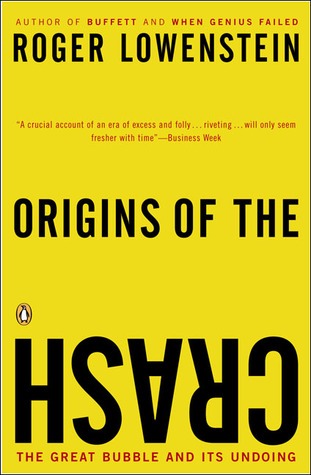Origins of the Crash Summary
5 min read ⌚
 The Great Bubble and its Undoing
The Great Bubble and its Undoing
From the end of the 20s until the beginning of the 80s, stocks were not a concern of most ordinary people. The great crash of 1929 brought forth the need to implement financial reforms.
Who Should Read “Origins of the Crash”? And Why?
“Origins of the Crash” is not a typical narrative which offers tips on how to ward off fraud, but it works more as a cautionary tale. It is recommended to anyone that suffered from the bubble burst or is interested in the topic.
About Roger Lowenstein
 Roger Lowenstein reports for the Wall Street Journal Journal, where, more than ten years ago, he wrote the columns “Intrinsic Value” and “Heard on the Street.” He also writes for The New York Times Magazine and is a columnist for SmartMoney magazine.
Roger Lowenstein reports for the Wall Street Journal Journal, where, more than ten years ago, he wrote the columns “Intrinsic Value” and “Heard on the Street.” He also writes for The New York Times Magazine and is a columnist for SmartMoney magazine.
He is the author of the bestselling Buffett: The Making of an American Capitalist and When Genius Failed: The Rise and Fall of Long-term Capital Management.
“Origins of the Crash Summary”
The creation of stricter disclosure laws was supposed to prevent the corruption and surplus that marked the 20s to recur. Undeterred by these improvements, the norm more or less stayed the same. The changes did prevent fraud, but connections remained the primary way top executives got their jobs.
In the late 70s, during raised inflation and a weak market, takeovers started to occur. By the beginning of the 80s, the LBO (leveraged buyout) became the new trend. The falling stock prices empowered these acquisition strategies even more.
Corporate executives, being threatened by this situation, started thinking about ways to raise their stock prices. They created an approach that allowed them to they were able to stimulate the demand for stocks artificially, and consequently to raise their prices.
Laying off employees, selling off branches and buying back their sold shares were all part of this scenario. They masked these steps with words such as cost cutting, share buybacks, and downsizing.
As a result, stocks became everyday commodities and ordinary people suddenly got interested in the stock market. The bad news started immensely affecting the companies’ stock prices. Under these circumstances, businesses changed their priorities. Now, the most important thing to them was rising stock prices.
With this intention in mind, companies started linking the CEOs’ compensation to the stock prices. However, this pay-for-performance reform did not bring companies any good. Executives received large option grants embodied in extravagant severance packages.
In a case of a drop in stock prices, the executives got option grants at a low price. Accordingly, when the stock prices increased, they could make a considerable amount of money, even if cases where the new price didn’t top the previous level.
In the end, what the pay-for-performance strategy did, was rewarding CEOs even if they didn’t do much. On top of that, no one ever penalized them. Accordingly, since they didn’t have anything to lose, they took more chances.
By the mid-90s, the market was blooming more than ever before. Investors started to appreciate shareholder value, more than business sustainability. After Netscape went public, another trend emerged.
Venture capitalists invested in new companies with limited history, trying to be first on the market. Concepts like profit which were once an essential variable for investors were labeled as belonging to the old economy. Everyone wanted to be part of the new craze – the Internet stock – market, which seemed to have a bright future ahead.
However, the future seemed brighter than it was in reality.
Key Lessons from “Origins of the Crash”
1. Market Mania Beginnings
2. The Birth of the Internet Bubble
3. The End of The Golden Years
Market Mania Beginnings
The market mania started when companies tried to survive the falling price of the stocks. Even though it started slowly, it soon led to coming up with activities that were on the line of being legal. Linking executives’ gains to the fluctuation of stock prices made many people rich overnight, but companies wanted more.
They started coming up with creative ways of doing business and reaping a profit while they did nothing to raise the actual value of their companies. They stopped caring about sustainable value, and all they cared about was stocks.
Stock prices could be manipulated, and they did that, first up till a point, and after, they took even illegal measures. Thinking it would last forever, they set their own trap in which, not long after, they were bound to get caught.
The Birth of the Internet Bubble
In 1985 InterNorth and Houston Natural Gas merged into creating Enron. As soon the merger happened, Enron tried to reestablish itself as a trading company, instead of continuing as an energy distributor.
For these purposes, the company’s executives used creative accounting methods. The CFO created SPVs (special purpose vehicles) to move debt off balance, to make Enron eligible for more credits. Furthermore, the head of trading launched new businesses, fostering a culture of entrepreneurial spirit.
The company’s CEO, on the other hand, was focused on making political connections and promoting Enron’s credentials.
These activities turned into fraud by 1997. Enron used shell partnerships to self-sell assets and made a fictional profit. Next, they started selling broadband fiber and waited for the right moment to enter the telecom industry. They did that with WorldCom. WorldCom used mergers to raise its share prices, which is a pretty unsustainable strategy.
But by then executives only cared about stock prices. Even at the cost of illegality.
The End of the Golden Years
The first time a merger showed its real ugly face was when Time Warner and AOL merged. Two months later, in March 2002, the internet bubble burst. The price of internet shares plummeted to 90%. Telecom shares didn’t drop as fast.
They continued rising for another year, while insiders sold their socks, knowing their value is only fictional. Enron started tumbling at the beginning of 2001.
Executives continued to artificially raise the value of the stocks, making their decline slower. However, in the meantime, they sold their shares, until the end of the year, when the company went bankrupt. The market fell, and scandals continued to appear.
In reality, ordinary citizens were the ones that were left to bear the consequences of other people’s fraud.
Like this summary? We’d Like to invite you to download our free 12 min app, for more amazing summaries and audiobooks.
“Origins of the Crash” Quotes
This was the ultimate irony of shareholder value. In a society honored around the world for its system of disclosure, truth had become a heresy. Click To Tweet The lack of an effective deterrent, combined with the perverse structure of stock options, meant that...many executives had an incentive to cheat. Click To Tweet The distinction between self-interest and greed is worth retaining, for it is a distinction that, in the ’90s, was utterly lost. Click To Tweet Finance has its own Peter Principle, by which a successful model will be adapted to progressively riskier cases until it fails. Click To Tweet People demand an explanation for crashes, but their origins are invariably to be found in the boom years that precede them. Click To TweetOur Critical Review
Robert Lowenstein tells a captivating thriller-like story that timelines of the rise and fall of the market craze in the late 90s.
The narration follows the bloom of creative accounting practices, the evolution of the dot-com era, and the fictitious shareholder value.
He writes of a society that allowed ordinary people to pay the price for the burst of a bubble created by the rich wanting to get richer.
Emir is the Head of Marketing at 12min. In his spare time, he loves to meditate and play soccer.


 The Great Bubble and its Undoing
The Great Bubble and its Undoing




